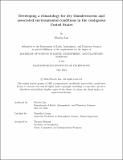Developing a climatology for dry thunderstorms and associated environmental conditions in the contiguous United States
Author(s)
Lin, Phoebe
DownloadThesis PDF (4.082Mb)
Advisor
Cronin, Timothy
Terms of use
Metadata
Show full item recordAbstract
Dry thunderstorms are the result of an interesting balance of meteorological variables: they require sufficient moisture and instability in the atmosphere, but also a dry surface layer that facilitates evaporation of falling precipitation. Here, lightning flashes and precipitation amounts for the contiguous United States from 2012-2022 are analyzed, comparing topography, relative humidity, seasonality, hour of the day, and other variables to identify patterns in dry thunderstorms. Dry flash density is found to peak in the Southwestern United States, and the dry lightning fraction for a threshold of 2.5 mm is greater than 1/2 in most of the areas west of the Rocky Mountains. Dry flashes are most active in the JJA and SON, but their location shifts west as the warm season progresses. The distribution of precipitation amounts associated with lightning suggest a difference in environments associated with dry thunderstorms and those that are too wet to be considered dry. The patterns identified here will be useful in preparing for hazards associated with dry thunderstorms.
Date issued
2024-05Department
Massachusetts Institute of Technology. Department of Earth, Atmospheric, and Planetary SciencesPublisher
Massachusetts Institute of Technology